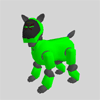3.0 Performance Files
AIBO performances or skits are composed of three
elements. Body motions,
LED's (eyes, tail, etc...), and Sound (either MIDI or
Wave).
Skitter has two ways of storing all this information.
Either as a single Aibo workbook, or as separate element files with an
Action file grouping
them together -- making a maximum of four files per skit.
Workbooks make copying & sharing easier, and are highly
recommended.
A given element can be reused by many different skits
(there
is no limit), but each skit requires a separate action file or workbook.
3.1 Creating New Performances
|
Create a new performance by clicking "New" on the
toolbar.
- Click the toolbar "New" button.
The AIBO platform
selection dialog appears.
- Select AIBO model. Choose
whichever
platform you
like and click OK.
- Edit the elements. Use the
motion,
LED, and sound editors.
- Save action file. Click
Save in the
toolbar.
|
After selecting an AIBO model,
Skitter creates blank motion, LED, and MIDI
sound elements for you.
To
remove unwanted elements from new skits, simply close the editor
window. On new actions, this removes the element from the
action (normally closing an editor just hides elements - you must
remove them explicitly).
To reuse elements from another performance, see:
"Reuse
Existing Files in a Performance".
|
|
3.2 Default Filenames
|
 When you save a new
performance, or use "Save-As" from the File menu,
Skitter prompts for an Action filename. For example, you
might
enter: When you save a new
performance, or use "Save-As" from the File menu,
Skitter prompts for an Action filename. For example, you
might
enter:
To help keep track of things, Skitter uses similar
filenames for
elements. ie:
|
|
Motion:
|
DANCE1.MTN
|
|
|
LED:
|
DANCE1.LED
|
|
|
Sound:
|
DANCE1.MID
|
Using similar filenames is recommended, but not
required.
They can be individually changed from the "File
Menu->Properties" option. Default filenames are shown in
red.
Skitter also creates subdirectories for the
different elements (Motion, LED, and Sound). If you prefer
everything in one place, change the file directory settings. From
the "Edit
Menu->Preferences", then "File Directories".
|
|
3.3 Navigating the Editor Windows
|
 Skitter can open three editors at
once for each performance:
Motion, LED, and Sound. You can maximize an editor to fill
the workspace, arrange the editors from the Window menu,
or size them manually. Skitter can open three editors at
once for each performance:
Motion, LED, and Sound. You can maximize an editor to fill
the workspace, arrange the editors from the Window menu,
or size them manually.
To bring an editor forward, click on the
Motion/LED/Sound
toolbar buttons. The
small checkmark shows the performance contains that element
type. No checkmark means the performance doesn't contain
that element type.
Clicking the toolbar buttons twice (or more)
toggles
that
editor between normal and maximized views (see below):

|

|
| Normal View |
Maximized View |
|
3.4 Reuse Existing Files in a Performance
You can share elements (such as a
motion file) across two or more performances.
After creating a new skit, select "Replace" from the Motion, LED, or
Sound menu (whichever needs replacing). Pick the file you
want, and you are done!
There are no restrictions on how many performances can reuse a single
element. Doing so can save lots of space on AIBO's memory stick,
and is common with LED & sound files.
|
 |
3.5 Add Elements to a Performance
If a performance is missing an
element,
you can add it easily. Just click the associated toolbar button
(Motion, LED or Sound). Note: If
the performance already has a sound element, clicking the toolbar
brings it to the
foreground
To replace an element, see "Reuse
Existing Files in a Performance ".
The dialog shown to the right appears when adding a sound
file. Skitter prompts to either create a new MIDI or Wave
file, or add an existing sound file (MIDI or Wave) from disk.
|
 |
3.6 Remove Elements from a Performance
If you decide a performance doesn't need an element (say a
LED file), you can remove it from the performance. Select
"Delete"
from the appropriate Motion, LED, or Sound menu.
The motion/led/sound element file is NOT deleted
from disk. Skitter simply doesn't include it with the current
performance anymore. If you change your mind, you can add
it back later -- no harm done.
Note: If you delete all elements,
Skitter closes the performance.
3.7 Using Skitter, Action Composer,
and/or AiboPet's Editor
There is no problem switching between the various editors.
However,
only open a given performance in one editor at a time. You
must use action files and not Aibo workbooks however.
Skitter supports copy/paste with Aibopet's Performance
Editor, but not Master Studio Action Composer (it doesn't support
standard Windows copy/paste).
|


 When you save a new
performance, or use "Save-As" from the File menu,
Skitter prompts for an Action filename. For example, you
might
enter:
When you save a new
performance, or use "Save-As" from the File menu,
Skitter prompts for an Action filename. For example, you
might
enter: Skitter can open three editors at
once for each performance:
Motion, LED, and Sound. You can maximize an editor to fill
the workspace, arrange the editors from the Window menu,
or size them manually.
Skitter can open three editors at
once for each performance:
Motion, LED, and Sound. You can maximize an editor to fill
the workspace, arrange the editors from the Window menu,
or size them manually. 


